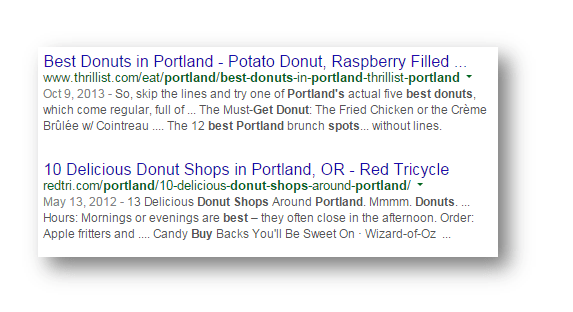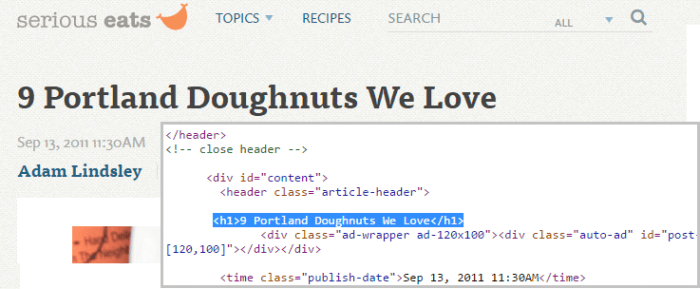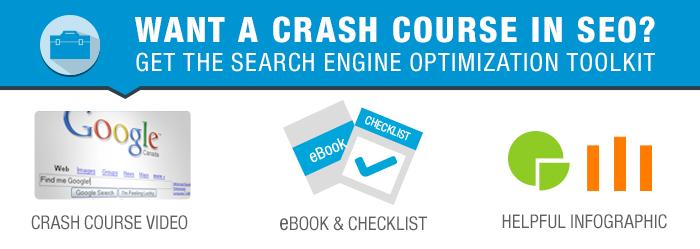 Writing copy for search engines is hard. It’s also a really bad idea. Not because search engines are cruel robots with algorithms where their hearts should be (although that is indeed what they are), but because the point of writing content on the web is to connect with people, not machines. The best-optimized page in the world may show up on the top of the first page of Google search results, but it’s not going to get clicked if it’s not optimized for the way people think. (And Google is getting better at knowing what people want, so even the best optimization may fall way below the first page if your content isn’t a good read.)
Writing copy for search engines is hard. It’s also a really bad idea. Not because search engines are cruel robots with algorithms where their hearts should be (although that is indeed what they are), but because the point of writing content on the web is to connect with people, not machines. The best-optimized page in the world may show up on the top of the first page of Google search results, but it’s not going to get clicked if it’s not optimized for the way people think. (And Google is getting better at knowing what people want, so even the best optimization may fall way below the first page if your content isn’t a good read.)
However, there are some very important areas of your page content to keep in mind when writing for the web. And they’re also easy to get wrong, because they seem similar. I’m talking about title tags, headings, and organizing page content.
Understanding the Title Tag
The title tag is the most important tag on the page. It helps tell both search engines and searchers what the page is about. It’s displayed when someone bookmarks your page, is shown as the title in search results, and appears at the top of a browser window when someone is looking at the page itself. It does not, however, show up in the content of the page, unless you write it in the content or use it as a headline. A well-written title tag uses the same keywords your audience is likely to use when looking for this content. It also helps your page rank and is likely to increase the number of searchers that click through to your content.
Tips for Better Title Tags
Writers like to be clever, because that’s an important part of the job – coming up with witty ways to say something that’s been said before. After all, Shakespeare reused plots that had been around for hundreds of years, but he did it in a new way. (In fact, 1,700 of the words used in his collected works were first used by him. Shakespeare would have had a hard time attracting searchers by using words and phrases that no one had ever heard of before. Good thing he stuck to play writing and never tried his hand at web content.)
For title tags, it’s usually a good idea to leave the cleverness out of it, and stick to this Shakespearean motto: “Brevity is the soul of wit.” Here are five ways to improve the results of your titles.
1. A good title tag should be short. Not long ago, guidance was to write a title tag that was fewer than 65 characters/spaces long, because that’s how many Google would display. Google now displays titles at a width of 482 pixels (or 512 pixels, depending on your source). How many characters you can use depends on which characters you use; the letter “l” for example, takes up fewer pixels than the letter “m.” You’re usually safe to stick to a total of 55 characters and spaces.
In this example, the title tag in the first result is 75 characters long, and as you can see, it gets cut off at 56 letters and spaces. The second result is 40 characters long. It manages to convey the topic and also to include the city, the state, and the name of the magazine. Keep in mind, the title tag also appears in the browser window (or tab) where it will only display the first few words (depending on the browser and number of tabs open).
Note also that different browsers display differently. The “Best Donuts” Firefox search above, done in Chrome and shown below, displays only 46 characters and spaces.
2. The title tag should accurately describe the page. Use the focus keyword in the title – this is the word (or phrase) you expect your target audience to use in order to find what they want. Your goal is a clear, concise explanation that sets the correct expectation for what the searcher will find if they click through to your page. “Best donuts in Portland” sets a different expectation than”The Rose City’s finest pastries.”
3. Make sure the title tag corresponds with the reasons people would visit the page. “Best donuts in Portland” will fulfill the search for the local audience that wants to eat; “Best donut-making classes in in Portland” will fulfill the search for the local audience that wants to cook.
4. Put the keyword early in the title. Ideally, you should use the focus keyword in the first 10 characters of the title, but don’t sacrifice a great title to force it. “Doughnuts – Portland – Guide” may be short and to the point, with the right words in the right order, but it’s optimized for robots, not people. And robots don’t eat doughnuts.
5. Each page of your web site should have a unique title tag. If the page is similar to another page and you’re thinking of using the same title tag, ask yourself if you really need the additional page.
By the way, did you notice doughnut is spelled differently in the examples above? “Donut” gets about 135,000 searches per month, according to Google AdWords, while “doughnut” gets approximately 49,500. And so, while “doughnut” is the correct spelling, you might want to consider using “donut” if you want to get more action on your pastry blog. (FYI, I spell doughnut correctly here, since I’m hoping to optimize this page for terms like SEO, title tags, and headings, not baked goods.) Consistent keyword spelling within a document or post is important, so if this post were actually about doughnuts, it would use the “donuts” spelling throughout.
Understanding H1 Tags
The H1 tag usually identifies the most important text on your page, and is often the headline. H1s help your audience understand what a page is about and quickly navigate to the sections that interest them. Search engines understand this, and analyze content with header tags <h1> to understand what a page is about. It’s important to keep this text relatively short. If you have a paragraph of text in an <h1> tag, search engines will think it is spam.
Tips for Better H1 Headings
There’s no technical limit to the length of an H1, but they are more effective if they are short and accurately describe the page. The reader uses them to decide whether or not to keep reading, so the fewer words you have, the more focus there is on the ones that count. It’s also a good idea to put the keyword in there early and to keep the keyword phrase in the same order as the rest of the page. It’s okay if the H1 and the title tags are the same, or if the H1 begins with the title tag.
While it’s technically true that you can have more than one H1 tag on the page, it’s not a good idea. If you have more than one main topic, you may need more than one page, each optimized for its own main idea.
You might think that the title is the title, and the H1 tag refers to the first level of subhead, but here’s what it looks like on the page:
Subheads are what the H2 through H6 tags are for. They organize your content into headings and subheadings, like an outline would do. For example, on a doughnut history page, the hierarchy might as look like this:
Title: History of the Doughnut
- H1: History of the Doughnut: Get the “Hole” Story
o H2: The Doughnut Throughout Time
- H3: Washington Irving and the “Dough Nut”
- H3: The Role of Doughnuts During World War I
- H3: East Coast Dunkin’ vs. West Coast Winchell’s
o H2: The Shape of Things to Come
- H3: Twists, Crullers, and Fritters
- H3: The Rise of the “Cronut”
Notice that you can have multiple H2 and H3 tags (indeed, you can drill all the way down to the H6 level, if you need to). But there should be only one H1. Notice also that you can also get a little clever with the H1 heading, but you’ll be better served if you have the topic right up front (“History of the Doughnut” and the fun part next, “Get the ‘Hole’ Story”.)
Remember, optimization is intended to help people find your content, and it’s possible to overdo it. Over-optimizing titles and headers in a manipulative way is going to mislead your readers as well as a search engine. A well-written page should include one or two keywords, but only because they are relevant and useful to users, in addition to a subtle but effective call to action.
Want to learn more about optimizing your site for humans as well as search engine robots? Download this toolkit to learn SEO strategies that enhance site visibility, increase the number of visitors coming to your site, and improve conversion rates.






